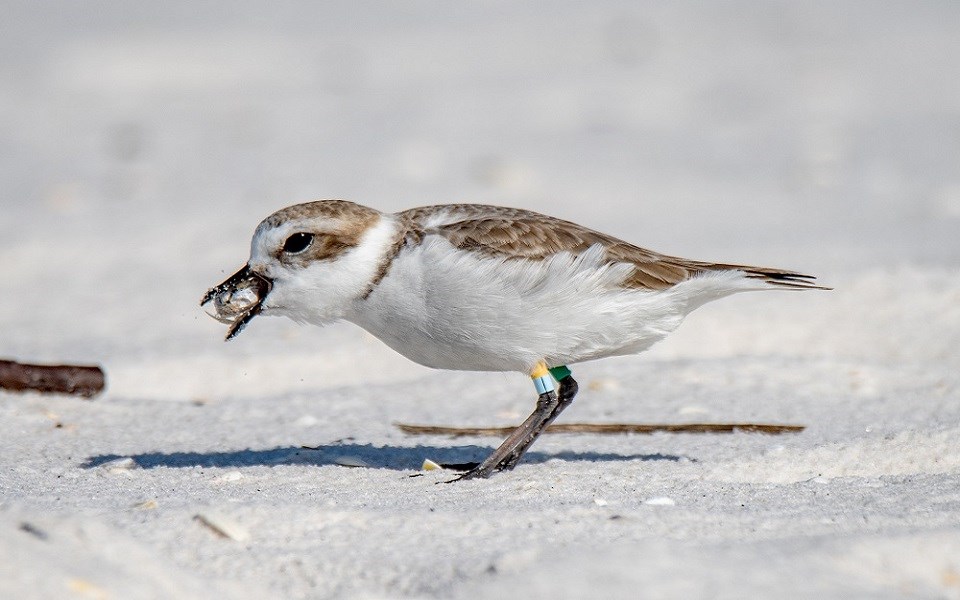
NPS/Doggrell This small snowy white shorebird can easily be overlooked on the white sandy beaches of Gulf Islands National Seashore. Snowy plovers differ from their close relative the piping plover by having lighter colored feathers, black legs and dark feet. Their bills are black and have large eyes with black, brown, and gray markings on wings and head. Snowy plovers weigh 34-58 grams (1.2 to 2 ounces) and range in length from 15-17 centimeters (5.9 to 6.6 inches).
There are two subspecies of snowy plovers in North America, the Western Snowy Plover (Chradrius alexandrinus nivosus) and the Cuban Snowy Plover (Chradrius alexandrinus tenuirostris). The cuban snowy plover’s range in Florida includes Gulf Islands National Seashore in the panhandle and all the way down the west coast of Florida.They also range from the Gulf of Mexico east of Louisiana, to the Yucatan Peninsula, Venezuela, coasts of Ecuador, Peri, Chile, the Carribean and West Indies. The subspecies are thought to be permanent residents of the areas they breed in. Snowy plover diet usually consists of clams, crabs, sand hoppers, seeds and marine worms. To catch prey, they typically run a few steps, pause and then run again, plucking at the ground when they spot food. Like other shorebirds including the black skimmer, least tern and american oystercatcher, snowy plovers are ground-nesters. They nest on a natural or scraped depression on dry ground typically lined with pebbles, shell fragments, fish bones, mud chips or vegetation fragments to blend in with the rest of the beach. Snowy plover eggs are only a few centimeters long and are pale buff, dotted with black. At the national seashore, nesting begins in late March. Many plovers will protect their nest by using distraction displays. If a nesting parent feels threatened, they deliberately attract the attention of the intruder, attempting to lure them away from the nest. Broken-wing displays typically involve spreading and dragging of a wing or tail, while slowly fluttering away from the nest or young. Young snowy plovers leave their nest within three hours of hatching. For protection they flatten themselves on the ground when a parent signals the approach of people or potential predators. The biggest threat to snowy plovers is habitat loss. Development in nesting habitats threatens snowy plover breeding. The national seashore closes off areas around nests because interference with the nest can cause adult birds to abandon their nests and leave eggs unprotected from predators. Natural predators of snowy plovers include foxes, snakes, large birds and ghost crabs. Development pushes new predators such as crows and coyotes closer to the nesting habitats of these birds.
If you come across a shorebird nest you should back out of the area, retracing your steps and let a national park ranger or volunteer know. Remain outside of closure areas. Be sure to observe posted speed limits during March-September and watch for birds flying across the road or traveling along the roadway. Many shorebird chicks are difficult to see on the road so be cautious on the roads during their breeding season. Bicyclists, walkers, and joggers are encouraged to be aware of bird behaviors along the roadways near posted nesting areas.
Proctor, N. S., & Lynch, P. J. (2012). A field guide to the southeast coast and Gulf of Mexico: Coastal habitats, seabirds, marine mammals, fish and other wildlife. New Haven, CT: Yale University Press All About Birds. “Snowy Plover: Life History.” Cornell University Lab of Ornithology. https://www.allaboutbirds.org/guide/Snowy_Plover/lifehistory |
Last updated: December 16, 2019
